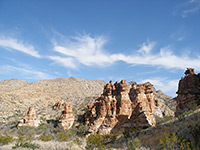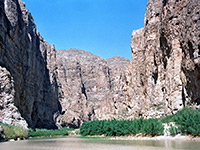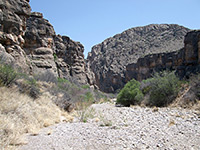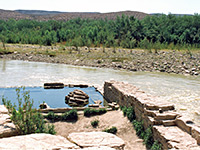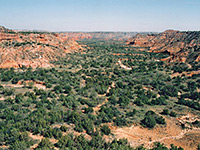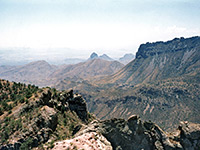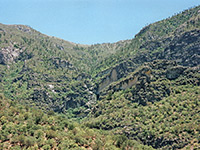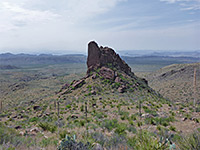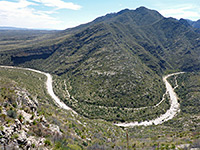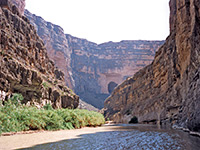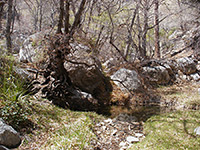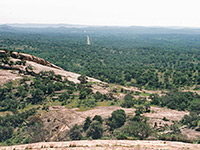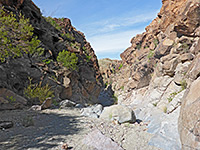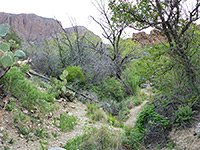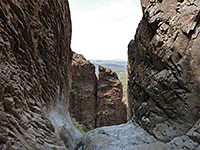West Texas Hiking Trails
Map shows trailhead locations
| 1. Apache Canyon Trail, Big Bend National Park Length 4.4 miles (7.1 km); to the rocks Elevation change 230 feet (70 meters) Difficulty Moderate; relatively long, and often very hot Rating (1-5) ★★★★★ Remote ravine on the west side of Burro Mesa containing unusual, brightly colored rocks, reached by a little-used trail across flat, grassy land. The latter section of the path descends into an adjacent drainage containing two historic ruins; the rocks are reached by a short, off-trail continuation hike. |
| 2. Bear Canyon, Guadalupe Mountains National Park Length 1.5 miles (2.4 km) Elevation change 2000 feet (610 meters) Difficulty Strenuous Rating (1-5) ★★★★★ Bear Canyon is a steep drainage east of Pine Spring Canyon; the path up the ravine is a less used alternative to the Tejas Trail for reaching the Guadalupe Mountains backcountry. It starts along the Frijole Trail in the desert foothills and ends at a junction with the Bowl Trail, in cool pine woodland at 8,000 feet. Although steep and rocky, much of the route is shaded by trees and in shadow during the morning, unlike the more exposed Tejas Trail. |
| 3. Blue Creek Canyon, Big Bend National Park Length 1.5 miles (2.4 km); to the red rocks Elevation change 240 feet (73 meters) Difficulty Easy, to the rocks Rating (1-5) ★★★★★ A disused but well preserved ranch building and a group of pointed red rock formations are the two attractions of the first 2 miles of the trail along Blue Creek Canyon, a route that continues upstream for several more miles, gaining height steadily, into the high country of the Chisos Mountains, where it meets the Laguna Meadows segment of the inner loop trail. |
| 4. Boquillas Canyon, Big Bend National Park Length 0.7 miles (1.1 km) Elevation change 40 feet (12 meters) Difficulty Easy Rating (1-5) ★★★★★ The entrance to Boquillas Canyon, one of the three great river gorges within Big Bend National Park, can be reached by a short trail that climbs over a ridge then passes through a riparian area close to the Rio Grande, ending at a pebbly beach. At times of low water it is possible to continue some distance downstream, by a combination of walking along sand banks and wading in the river. |
| 5. Bowl Trail, Guadalupe Mountains National Park Length 4.7 miles (7.6 km); (loop) Elevation change 600 feet (183 meters) Difficulty Easy to moderate; a few steep sections Rating (1-5) ★★★★★ High above the desert lowlands, the sheltered pine and fir forest of the Bowl is circled by a loop trail that connects the Bear Canyon and Tejas trails and has a 0.3 mile spur to the summit of 8,368 foot Hunter Peak. Another junction is with the Juniper Trail, an alternative connector to the Tejas Trail for continuation trips further north. |
| 6. Burro Mesa Pouroff, Big Bend National Park Length 0.5 miles (0.8 km) Elevation change 50 feet (15 meters) Difficulty Easy Rating (1-5) ★★★★★ This well used path to a narrow pouroff crosses sandy ground then follows a dry wash to the base of the cliffs; the drainage continues high above (reached by the separate Upper Burro Mesa Pouroff Trail). The lower path is accessed from a paved side road, forking off Ross Maxwell Scenic Drive. |
| 7. Cattail Falls Trail, Big Bend National Park Length 1.5 miles (2.4 km) Elevation change 360 feet (110 meters) Difficulty Easy Rating (1-5) ★★★★★ Cattail Falls is a beautiful, hidden waterfall above an enchanting series of pools, in a wooded canyon on the west side of the Chisos Mountains; reached by a little-publicized trail across undulating desert hills. The falls are home to several rare plants. |
| 8. Closed Canyon, Big Bend Ranch State Park Length 0.8 miles (1.3 km); to the dryfall Elevation change 0 feet (0 meters) Difficulty Easy Rating (1-5) ★★★★★ Short route along a deep, enclosed, sheer-walled canyon through dark, metamorphic rocks. The gorge meets the Rio Grande though ropes are needed to overcome a dryfall near the end. |
| 9. Devils Den, Big Bend National Park Length 3.5 miles (5.6 km) Elevation change 300 feet (91 meters) Difficulty Moderate Rating (1-5) ★★★★★ A primitive, cairned trail forks south off the well-used route to Dog Canyon after about 1 mile, following dry washes to the Devil's Den - a narrow slot-like canyon through limestone cliffs, where upstream progress requires scrambling over small dryfalls and other obstacles. |
| 10. Devils Hall, Guadalupe Mountains National Park Length 2.1 miles (3.4 km) Elevation change 750 feet (229 meters) Difficulty Easy to moderate Rating (1-5) ★★★★★ Devil's Hall is a narrow, 200 foot deep, vertical-walled ravine through thin-layered limestone strata, and may be reached by a fairly level trail up Pine Spring Canyon. The last mile is over pebbles and boulders along the streambed. |
| 11. Dog Canyon, Big Bend National Park Length 2 miles (3.2 km) Elevation change 40 feet (12 meters) Difficulty Easy Rating (1-5) ★★★★★ Dog Canyon is a short but narrow and steep-walled limestone gorge cutting through the Santiago Mountains, near the northern park entrance at Persimmon Gap. The easy trail to the mouth of the canyon crosses desert flats filled with many species of cacti. |
| 12. Dome Trail, Big Bend Ranch State Park Length 3.6 miles (5.8 km); one way to Cinnabar Mine Elevation change 400 feet (122 meters) Difficulty Moderate - not steep, but quite long Rating (1-5) ★★★★★ Partial loop, totaling 11 miles, over remote terrain of washes and undulating hills in the southeast corner of the state park, reached via the West Main Trail; passes a great variety of desert plants. Also open to mountain bikes, and suitable for shorter hikes, such as to Cinnabar Mine. |
| 13. Emory Peak, Big Bend National Park Length 1 mile (1.6 km) Elevation change 900 feet (274 meters) Difficulty Moderate; strenuous for the full hike (4.5 miles) Rating (1-5) ★★★★★ The trail to the summit of Emory Peak, the highest point in the national park, climbs steadily up a mostly forested ridge, ending with a short scramble up a near-vertical cliff. The path is reached by the 3.5 mile Pinnacles Trail, making the round trip to the summit about 9 miles (2,450 foot elevation gain). |
| 14. Guadalupe Peak, Guadalupe Mountains National Park Length 4.2 miles (6.8 km) Elevation change 2940 feet (896 meters) Difficulty Moderate to strenuous Rating (1-5) ★★★★★ The highest peak in Texas rises nearly 3,000 feet above Pine Spring campground, starting point for the strenuous trail to the summit. The path is very steep in places but well maintained and has fantastic views all the way. |
| 15. Hot Springs, Big Bend National Park Length 3 miles (4.8 km) Elevation change 250 feet (76 meters) Difficulty Moderate; strenuous in summer Rating (1-5) ★★★★★ The Hot Springs alongside the Rio Grande can be reached either by a gravel track (not for RVs), leaving Hwy 118 a few miles from Rio Grande Village, or by a pleasant 3 mile trail, crossing desert land with many and varied cacti, and frequent views of the river gorge (Hot Springs Canyon). The trail starts a little way west of the village, at the end of the spur road to Daniels Ranch. |
| 16. Lighthouse Trail, Palo Duro Canyon State Park Length 3 miles (4.8 km) Elevation change 900 feet (274 meters) Difficulty Easy Rating (1-5) ★★★★★ Mostly level route along a fairly wide canyon to one of the best known formations in the state park, a red rock pillar at the edge of eroded cliffs. |
| 17. Lost Mine, Big Bend National Park Length 2.4 miles (3.9 km) Elevation change 1200 feet (366 meters) Difficulty Moderate Rating (1-5) ★★★★★ From a pull-out along the Chisos Basin Road near Panther Pass, this often busy trail climbs a tree-covered hillside and a bushy ravine to a high, narrow ridge separating the upper ends of Juniper Canyon and Pine Canyon, providing an excellent introduction to the scenery of the Chisos Mountains. |
| 18. Marufo Vega, Big Bend National Park Length 14 miles (22.5 km); (loop) Elevation change 1000 feet (305 meters) Difficulty Strenuous, especially in summer Rating (1-5) ★★★★★ Perhaps the most difficult day hike in Big Bend, the Marufo Vega loop trail crosses hostile, mountainous terrain, exceedingly hot and dry during the summer months, and descends steeply down a canyon to the banks of the Rio Grande, deep within Boquillas Canyon. The route follows the river bank for a mile then returns via an equally steep climb up an adjacent ravine. |
| 19. McKittrick Canyon, Guadalupe Mountains National Park Length 3.4 miles (5.5 km); to the Grotto Elevation change 2700 feet (823 meters) Difficulty Easy Rating (1-5) ★★★★★ McKittrick is the most scenic canyon in the national park - a shallow stream flows year-round, and the lower few miles have abundant vegetation and wildlife. Two possible destinations for a day hike are an old wooden cabin after 2.4 miles and a limestone grotto after 3.4 miles; both have a small picnic area nearby. Beyond the grotto the trail climbs very steeply above the valley, up to 7,716 foot McKittrick Ridge, (location of a backcountry campsite), then crosses more undulating terrain along the edge of an escarpment to a junction with the Tejas Trail. |
| 20. Mule Ears, Big Bend National Park Length 1.9 miles (3.1 km); to Mule Ears Spring Elevation change 100 feet (30 meters) Difficulty Easy Rating (1-5) ★★★★★ The Mule Ears Spring trail winds over typical Chihuahaun Desert land of small peaks, sandy flats and dry washes, to a cottonwood tree-lined oasis. Start point is Mule Ears Overlook, along the Ross Maxwell Scenic Drive 8 miles north of Castolon. Past the spring, the trail continues to a junction with a backpacking route linking the Chisos Mountains with the River Road. |
| 21. Oak Spring Trail, Big Bend National Park Length 2.3 miles (3.7 km) Elevation change 950 feet (290 meters) Difficulty Moderate - steep, exposed, and hot in summer Rating (1-5) ★★★★★ Connecting path between the desert lowlands and the Chisos Mountains; starts in the bushy valley below Oak Spring, climbs steadily to a ridge above the Window (a high pour-off) then descends into the canyon of Oak Creek, meeting the Window Trail. Many wildflowers on the mountain slopes. |
| 22. Permian Reef Trail, Guadalupe Mountains National Park Length 4.8 miles (7.7 km); to the park boundary Elevation change 2000 feet (610 meters) Difficulty Moderate to strenuous Rating (1-5) ★★★★★ The Permian Reef Trail ascends the north side of McKittrick Canyon, gaining height steadily via many switchbacks up to flat-topped Wilderness Ridge (7,000 feet, location of a primitive campsite), then continues northwards into the Lincoln National Forest. Numbered signs en route correspond to articles in a geology guidebook sold at the national park visitor center. |
| 23. Pinnacles Trail, Big Bend National Park Length 3.5 miles (5.6 km) Elevation change 1600 feet (488 meters) Difficulty Strenuous Rating (1-5) ★★★★★ The Pinnacles Trail provides one of the two routes southwards from Chisos Basin into the high country of the Chisos Mountains. It starts by crossing the south side of the basin - bushy, sloping ground with somewhat limited views - then climbs steeply to a plateau between Emory Peak and Toll Mountain. From here the Boot Spring Trail continues further south while the Emory Peak Trail branches off westwards. |
| 24. Rancherias Canyon, Big Bend Ranch State Park Length 2.4 miles (3.9 km); to the spring Elevation change 400 feet (122 meters) Difficulty Easy Rating (1-5) ★★★★★ Typically scenic and unspoilt Chihuahuan Desert canyon, alternating between enclosed and more open sections, with springs and a short stream towards the lower end. |
| 25. Santa Elena Canyon, Big Bend National Park Length 0.8 miles (1.3 km) Elevation change 40 feet (12 meters) Difficulty Easy Rating (1-5) ★★★★★ Santa Elena is most spectacular canyon in the national park, formed as the Rio Grande cuts through the 1,200 foot cliffs of Sierra Ponce. The mouth of the canyon is reached by a popular trail that crosses the lower end of Terlingua Creek (wading may be necessary), climbs up and over a rocky outcrop and ends on a sandbank next to the river; beyond here the water covers all the canyon floor, but the river is often shallow enough to allow continuation hikes upstream. |
| 26. Smith Spring, Guadalupe Mountains National Park Length 2.3 miles (3.7 km); (loop) Elevation change 220 feet (67 meters) Difficulty Easy Rating (1-5) ★★★★★ This easy loop first leads to Manzanita Spring, in a grassy clearing close to Frijole Ranch, then climbs up open hillsides below Frijole Ridge to the larger Smith Spring, set in shady maple/oak/pine woodland in a small canyon. The return is via another path a little way west. The first section to Manzanita Spring (0.2 miles) is paved and accessible to wheelchairs. |
| 27. Summit Trail, Enchanted Rock State Natural Area Length 0.5 miles (0.8 km) Elevation change 425 feet (130 meters) Difficulty Easy Rating (1-5) ★★★★★ This trail provides an easy, fairly direct route to the top of the highest rock in the state park, initially over partly overgrown slopes with boulders, then across bare rock. |
| 28. Tejas, Guadalupe Mountains National Park Length 3.3 miles (5.3 km); to the Bowl Trail Elevation change 2100 feet (640 meters) Difficulty Strenuous Rating (1-5) ★★★★★ The longest trail in the Guadalupe Mountains links the park headquarters at the mouth of Pine Spring Canyon with the northern entrance in Dog Canyon - 11 miles in all, across a succession of ridges and valleys. The steepest but most used section is the southernmost 3.3 miles, which form part of the 9 mile loop to Hunter Peak, also involving the Bowl, Bear Canyon and Frijole trails. There are three primitive campsites along the way, and junctions with several other paths including the Marcus, Juniper and McKittrick Canyon trails. |
| 29. Tuff Canyon, Big Bend National Park Length 0.2 miles (0.3 km) Elevation change 0 feet (0 meters) Difficulty Easy Rating (1-5) ★★★★★ There are many box canyons in Big Bend - shallow but sheer-walled ravines, cutting across the desert plains. Tuff Canyon is a good example, located right next to the Ross Maxwell Scenic Drive and viewable by a very short trail. |
| 30. Upper Burro Mesa Pouroff, Big Bend National Park Length 1.8 miles (2.9 km) Elevation change 200 feet (61 meters) Difficulty Easy to moderate; some scrambling over obstructions Rating (1-5) ★★★★★ The increasingly narrow and rocky ravine formed by Javelina Wash provides a course for a primitive but relatively easy trail that ends at the top of a 100 foot dryfall, at the edge of Burro Mesa. The foot of the pouroff is reached by a separate, shorter path; both begin along the Ross Maxwell Scenic Drive. |
| 31. Upper Canyon and Haynes Ridge Overlook Trails, Caprock Canyons State Park Length 7 miles (11.3 km); round trip Elevation change 650 feet (198 meters) Difficulty Moderate Rating (1-5) ★★★★★ Circular route up a narrowing canyon to a cool, sheltered grotto (Fern Cave), followed by a steep climb to the top of the plateau, a traverse of open country and a sharp descent back to the trailhead; varied scenery, and good views. |
| 32. Ward Spring, Big Bend National Park Length 1.6 miles (2.6 km) Elevation change 450 feet (137 meters) Difficulty Easy Rating (1-5) ★★★★★ Minor water source in a shallow, overgrown ravine, along the upper section of Cottonwood Creek - in the western foothills of the Chisos Mountains. The lightly used trail crosses open flats and small ridges, past a good selection of cacti and wildflowers. |
| 33. Window Trail, Big Bend National Park Length 2.2 miles (3.5 km) Elevation change 560 feet (171 meters) Difficulty Easy Rating (1-5) ★★★★★ The Window Trail follows a streamway westwards (downstream), starting at the Chisos Basin campground and ending at the brink of a 200 foot dryfall, at the edge of mountains. The route becomes increasingly overgrown, and as the Window approaches the canyon is lined with oak trees and riparian vegetation. |
All Contents © Copyright The American Southwest | Comments and Questions | Contribute | Affiliate Marketing Disclosure | Site Map


